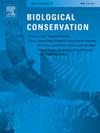Spatial ecology of recolonized elk in agricultural landscapes of the Northern Great Plains
IF 4.9
1区 环境科学与生态学
Q1 BIODIVERSITY CONSERVATION
引用次数: 0
Abstract
Mitigating human-wildlife conflict for recolonized populations of large mammals requires understanding spatial responses to variation in natural and anthropogenic landscape features. Elk recolonized Nebraska, USA in the 1960's and have since expanded geographically and numerically. Elk are a high-profile species of management concern that cause agricultural crop depredation but are valued as a harvested species. Managers lack empirical understanding of their spatial ecology in agriculturally dominated landscapes of much of the Northern Great Plains, resulting in uncertainty for depredation and harvest management. We quantified home range size and seasonal movements of 153 GPS-collared elk (103 females, 50 males) in Nebraska across gradients of natural habitat and agriculture. Elk used smaller home ranges in areas with greater vegetative cover, more cornfields, and more evenly distributed forage. Elk used larger home ranges in areas with more roads and development. Thus, human disturbance fragments the landscape for elk, while also providing agricultural subsidies. Elk moved greater distances to leave areas with greater risk to access areas with substantial cropland when establishing calving and fall ranges. Additionally, elk moved greater distances between seasonal home ranges when transitioning from areas with reduced natural forage. Our results suggest that elk shift space use seasonally to exploit both natural and agricultural forage, but that increased availability of natural forage may reduce seasonal movements of elk into cropland. Thus, management of elk in agricultural landscapes should prioritize providing quality natural habitat to mitigate human-wildlife conflict. Our work highlights the disparate influence of human disturbance on wildlife space use.
北方大平原农业景观中麋鹿再定居的空间生态
减轻大型哺乳动物重新定居种群的人类与野生动物冲突需要了解自然和人为景观特征变化的空间响应。麋鹿在20世纪60年代重新进入美国内布拉斯加州,并在地理上和数量上扩大了。麋鹿是一种备受关注的管理物种,它会导致农作物的掠夺,但作为一种收获物种却很有价值。管理人员缺乏对北方大平原大部分地区农业主导景观的空间生态的经验认识,导致掠夺和收获管理的不确定性。本文对美国内布拉斯加州153头gps项圈麋鹿(103头雌性,50头雄性)在自然生境和农业上的活动范围和季节活动进行了量化。麋鹿在植被覆盖更广、玉米地更多、饲料分布更均匀的地区使用较小的活动范围。麋鹿在有更多道路和发展的地区有更大的活动范围。因此,人类的干扰破坏了麋鹿的景观,同时也提供了农业补贴。在建立产犊和坠落范围时,麋鹿会移动更远的距离,离开风险更大的地区,进入有大量农田的地区。此外,当麋鹿从自然饲料减少的地区过渡时,它们在季节性栖息地之间移动的距离更大。我们的研究结果表明,麋鹿的季节性移动空间利用自然和农业饲料,但自然饲料的可用性增加可能会减少麋鹿进入农田的季节性移动。因此,在农业景观中管理麋鹿应优先提供高质量的自然栖息地,以减轻人类与野生动物的冲突。我们的工作强调了人类干扰对野生动物空间使用的不同影响。
本文章由计算机程序翻译,如有差异,请以英文原文为准。
求助全文
约1分钟内获得全文
求助全文
来源期刊

Biological Conservation
环境科学-环境科学
CiteScore
10.20
自引率
3.40%
发文量
295
审稿时长
61 days
期刊介绍:
Biological Conservation is an international leading journal in the discipline of conservation biology. The journal publishes articles spanning a diverse range of fields that contribute to the biological, sociological, and economic dimensions of conservation and natural resource management. The primary aim of Biological Conservation is the publication of high-quality papers that advance the science and practice of conservation, or which demonstrate the application of conservation principles for natural resource management and policy. Therefore it will be of interest to a broad international readership.
 求助内容:
求助内容: 应助结果提醒方式:
应助结果提醒方式:


